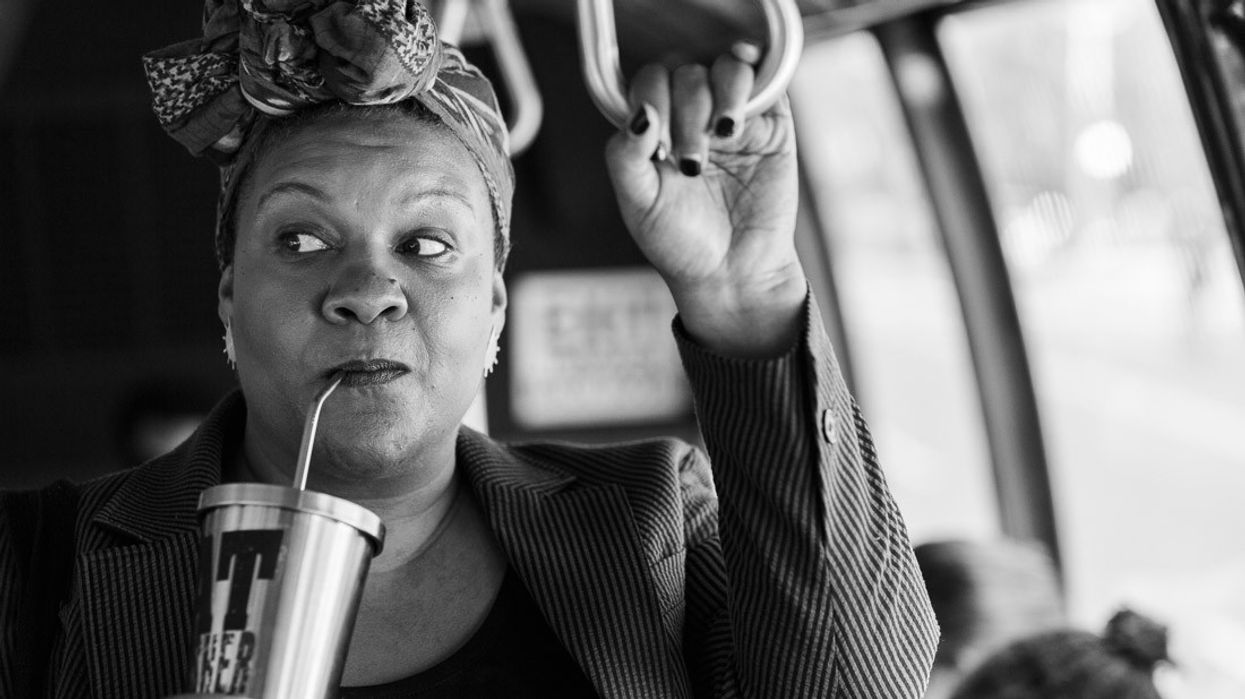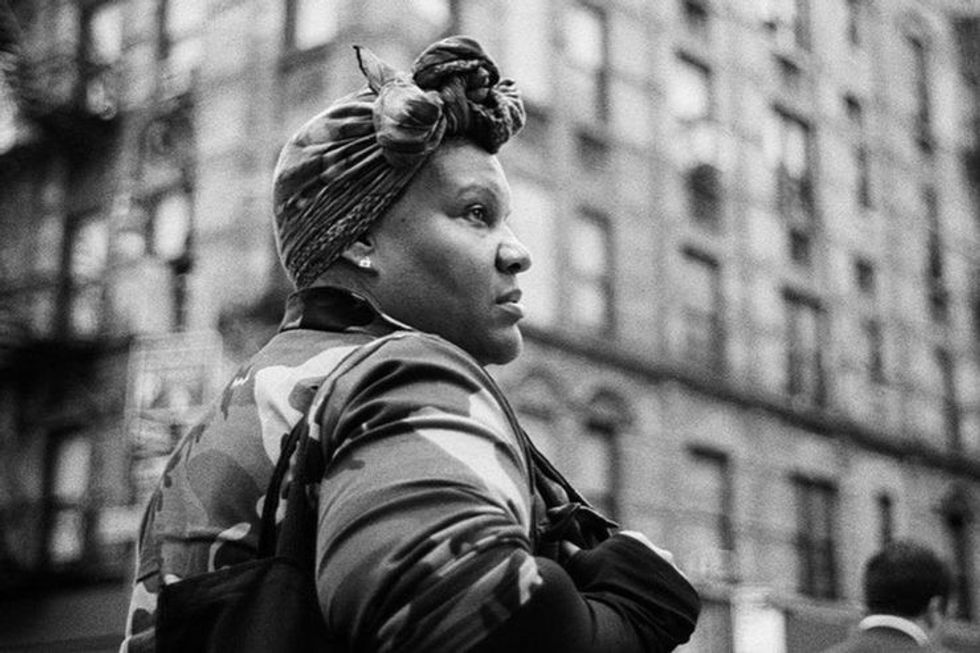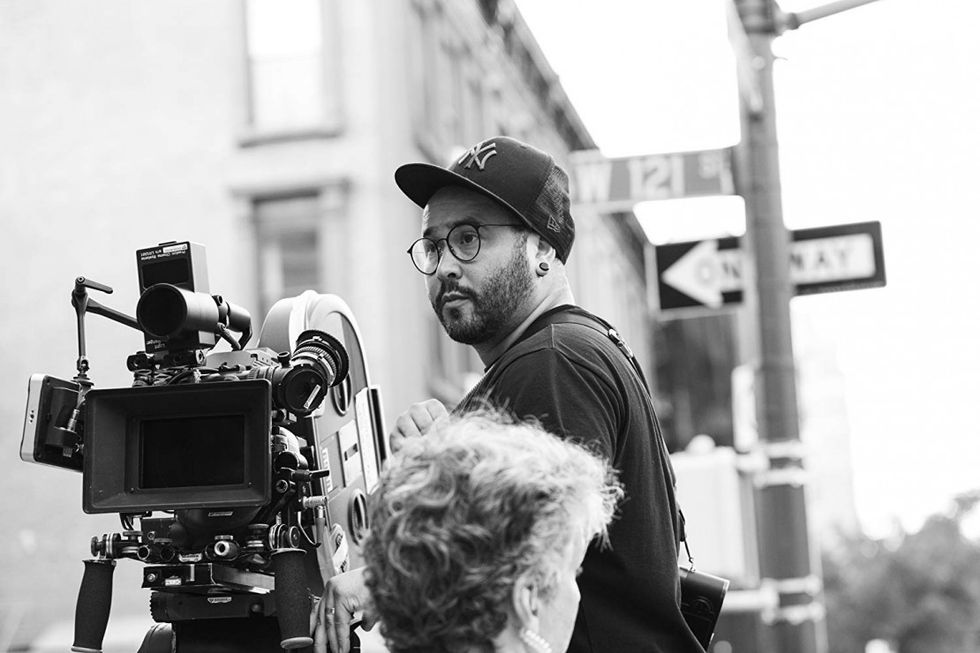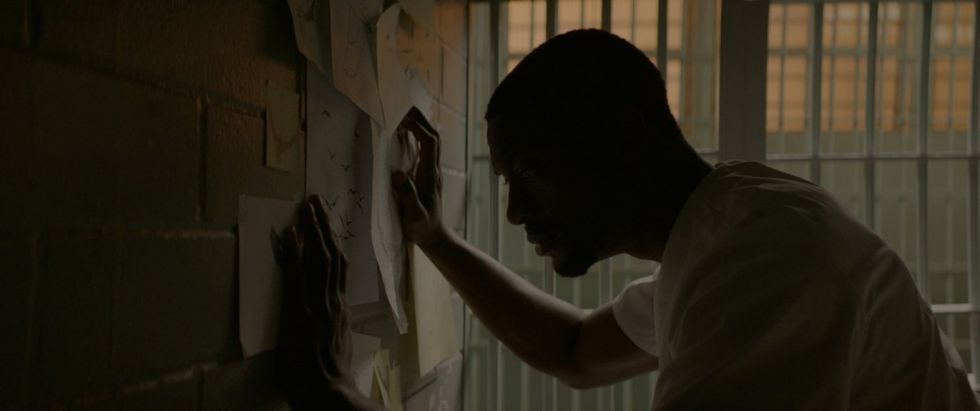The Genius Color Filtration and Lighting Hacks of Sundance Breakout 'The 40-Year-Old Version'
Shooting on 35mm black-and-white stock, cinematographer Eric Branco employed some creative techniques to bring this shimmering comedy to life.

"The play rang a little inauthentic," says an older white producer to an up-and-coming black playwright. "I asked myself, 'Did a black person really write this?" (It's a chamber piece about a black family reckoning with a gentrifying Harlem.) To "grab the core audience," the producer suggests she write white people—the gentrifiers—into the play. He casually adds that he's still looking for someone to pen his Harriet Tubman musical.
Such is life for the protagonist of The 40-Year-Old Version, Radha Blank's hilariously candid feature debut. Blank, who also wrote the film, stars as a version of herself who just can't seem to get it together. She's single, and what was once a promising career on Broadway has all but faded into an uninspiring job teaching students in Harlem. If this is a recipe for a mid-life crisis, Radha isn't going to take it lying down. But just as she finds a satisfying new outlet for creative expression—rapping—the old white Broadway mogul offers to produce Radha's play. There's a catch, of course: she has to rewrite it as a white people feel-good play.
The 40-Year-Old Version is an urgent window into the myriad ways black artists have to compromise to be seen. The black-and-white cinematography, by Eric Branco, is as vibrant and exploratory as the star herself. No Film School sat down with Branco before the film's Sundance premiere to discuss what he describes as "outside-the-box" techniques, including how he developed color filtration for dark skin, intentionally under-lit certain scenes, lit an entire apartment from another apartment across the street, and more.
"We wanted to try and punch up our visuals a little more than what you would normally think a comedy would look like."
No Film School: The film is getting a lot of buzz pre-festival!
Eric Branco: It's one of those things—you make a movie and you just never know how people are going to respond to it. So it's always a big exhale when people seem to be into seeing it!
NFS: It's like you live in this universe with it during production, and you have no idea what it looks like outside of that.
Branco: Exactly.
NFS: So, you shot Clemency, which was at Sundance last year. Before that, I see you’ve shot a lot of shorts—was Clemency your first feature, which would make this your second?
Branco: Well, the features I've shot have been very, very small things that didn't go anywhere. Maybe that's not fair to say. You know, there are tiers of features. The 40-Year-Old Version is, I think, the beginning of kind of a new run of features I’ve shot that people will see. But in total, this is probably my seventh feature.
NFS: Tell me about how you got involved The 40-Year-Old Version in the first place.
Branco: I have known Radha for years. We met at a festival in Philly called BlackStar in 2014. We've just kind of been acquaintances—orbiting in the same system for a while. I always knew her as a playwright, and I knew her as her RadhaMUSprime [rapper] alter ego. I actually didn't know that she was interested in making films. So I was really pleasantly surprised when I got the call for this.
NFS: What were your first conversations with Radha about what you would like to do visually with the film?
Branco: I shoot a lot of still photography in black and white on my own, and something that I've been exploring over the last year or so is color black-and-white filtration for darker skin. The way we think about shooting black and white comes from the fact that when black and white was at its height, pretty much everything was designed for Caucasian skin. So, I've been interested in figuring out these filter combinations for darker skin. You know, the typical nerd stuff DPs do when you're not actually on a film.
So, funny story: I got an email from one of her producers, just kind of as a temperature check. Like, “Hey, I have this feature coming up, and I’m looking to see if you're available.” About a week later, I was doing some camera testing for those black-and-white color filtration combinations. I finish up, get in my car, and check my phone. I have an email, and it's the look book, and I realize that The 40-Year-Old Version is going to be shot in black and white. I had no idea!
I immediately read the script and loved it. Radha and I decided to meet up. I packed a suitcase full of my black-and-white photography books to take with me. We sat down and immediately tore through all these books. We talked look, feeling, tone.

NFS: What filtration techniques, specifically, were you developing, and how did you implement those on this film?
Branco: It's kind of counterintuitive, but a good amount of black-and-white photography actually utilizes color filters—especially landscape photography. The way it works is whatever color filter you put in front of your lens, that color will transmit as brighter, and it will darken opposing colors. So if you want to shoot a landscape, and you want a really dark, rich sky, you would use a red filter, which would make the blue sky go dark. Same if you're shooting a rose: without color filtration, you're going to have the red and green of a rose look somewhat similar in grayscale. So if you want to add contrast to that and make the petals pop, you would use a red filter, which would make the petals much lighter, and because red opposes green on the color wheel, it's going to push the green darker.
This [practice of using color filtration] was common when shooting actresses on black-and-white film. You wanted them to appear more “pure”—that's how people used to think about photographing women. Lighter skin was considered more attractive, so you would use a peach filter or an orange filter, which would allow Caucasian skin tones to come to the forefront.
Nobody ever developed color filtration for darker skin. So I was testing a bunch of different filters, trying to find a combo that would work. I was working with filters like tobacco and chocolate. If you were shooting a Western and you wanted the town to appear really dusty and hazy, you might use a tobacco filter, which is going to give everything a sweet brown tinge that's pretty similar to African-American skin tones.
"I don't necessarily go for the most traditional solution. We were pretty outside-the-box."
NFS: Tell me about your overall philosophy on lighting this film.
Branco: You know, this is a comedy. This is no shade at other comedy films, but we wanted to try and punch up our visuals a little more than what you would normally think a comedy would look like.
Radha really wanted it to feel as if the camera was dropped into the environment. This was our main challenge with lighting. So there are a lot of long takes where we see 360. The goal was to be able to light without seeing stands.
It was about finding a middle ground of making [the cinematography] visually interesting, but when it's time to turn around or do a new shot, you don't have to relight anything. That totally kills the momentum of the scene. Especially in a comedy, actors are doing their thing—everyone is riffing off of each other. I feel like it's a disservice to the film if the set has to shut down for a half-hour so we can turn around to the other side of the room.

NFS: You intentionally underlit certain scenes, too. I like how you played around with that.
Branco: Yeah, that was something that we talked about early on. It's much like writing or music—if everything stays on one tone throughout, there is the danger of the audience getting fatigued or not paying attention. So, for a lot of the scenes where we switch it up and things go dark... that was kind of our way of saying, "We really, really want you to look at this right now. This is important." We wanted to train your eye on how to watch this film.
NFS: You mentioned a bit about lighting for 360. How exactly did you rig those setups?
Branco: I don't necessarily go for the most traditional solution. We were pretty outside-the-box.
For a lot of our night exterior street scenes, we would rent a room in a building across the street and light from that building. We'd just shine lights down onto the street. When you light that way, it's lit, but it doesn't feel like a movie. We had an approach that was a little more streamlined. For example, if we were looking this way, and suddenly we realized that we want to pick up a reverse on a character, we could still do that without having to worry about rolling a crane back to the other side of the street and blocking traffic. This approach kept us light and nimble on our feet.
"Mirrors are interesting because you can put one light up and essentially turn it into four lights that are going in four directions."
NFS: Did that approach to lighting produce any unexpected challenges?
Branco: Lighting Radha's apartment was our biggest challenge. We had a game plan, and then suddenly the plan shifted, and then we had to come up with something new. We were in a tough place. At our shooting location, they had just wrapped West Side Story, and I think all the residents were like, "Oh my God, another film?!" And so they wouldn't give us permits for a lot of stuff. That was a situation where I did want to get a big crane up and shoot light into her apartment, and they wouldn't let us do it.
My key grip Scott DeAngelo and my gaffer, Tyler Harmon-Townsend, came up with a solution where we rigged a 12x24 foot Ultrabounce off of the top of Radha's building, and then put lights down on the street level shooting up to help carry light into her apartment. That satisfied the city rules because none of our lights were on the building property. But we had to do it so that when we're in her interior apartment, we can still look out the windows and not see lights.
Similarly, in the classroom scenes, my plan was to light those scenes from the rooftop of a building across the street. On the night of the shoot, the building backed out, and so we didn't have the ability to get lights on that building anymore. We had a day that was something like seven pages, with a fight scene in it. So the room had to be lit.
We actually used a bank of one-foot-by-one-foot mirrors above all the windows, and we rigged all of our lights in the ceiling on the opposite side of the room. We shot them across the room at the mirrors, and then we would adjust our mirrors so that every character was lit. The light still looked like it was coming from the window—the direction was correct. Mirrors are interesting because you can put one light up and essentially turn it into four lights that are going in four directions. I guess that was another example of a challenge bested.

NFS: It was hard to tell whether this was tightly scripted, or there was a little bit of improv involved.
Branco: Everything was pretty much on the page. And that's a testament to Radha's writing, in that it all feels natural. It feels like the words are coming out of the characters, not out of the actors.
Likewise with the camera. I mean, we wanted it to feel spontaneous. We wanted the cinematography to have a rough-around-the-edges quality, but every camera move was very, very rehearsed. I don't think there's anything in the film that was not designed.
"We wanted the cinematography to have a rough-around-the-edges quality, but every camera move was very, very rehearsed."
NFS: Which camera did you shoot with, and which lenses?
Branco: We shot on the ARRI LT camera on 35mm film, black and white. Our main stock was Kodak 5222, which hasn't been updated since the '60s. Most black-and-white films post-WWII have been shot on this stock, including Manhattan, which was obviously a big reference for us.
We shot on Zeiss Super Speeds because they're really small and lightweight, and they open up really wide. Some of this movie was shot in very, very dark environments, so it was important to have a lens that could capture all of that. But more importantly, I just know them really well. I've shot tons of film, but this is my first black-and-white film. Since we were doing a lot of things with filtration and lighting and camera movement, I made the choice to fall back on a lens that I was very, very familiar with. I knew how the lens would perform in any situation.
NFS: Have you been to Sundance before?
Branco: This is my third feature at Sundance. The first was a horror film called VHS, which premiered in 2012, I think. And then Clemency was my first feature in competition.
NFS: What is your role as a DP on the ground here at the festival?
Branco: I think for me, Sundance is more about putting faces to names for people that you may have a peripheral knowledge of but have never met. And then it's like, you have a beer together, and then you're best friends.
Sundance, for me, is also about [sharing knowledge]. There is a lot of attention paid to the craft industries of the art of filmmaking. Even though I'm a DP, I will be at a costume design panel at Sundance. I'm trying to soak up knowledge. I'm a sponge for anything that will make me better at my job, even tangentially.
NFS: On that note, do you have any advice for up-and-coming DPs who, for example, have shot a bunch of shorts, but are looking to make the leap to feature?
Branco: I'd just go shoot a feature, honestly. You know, filmmaking is frustrating because you need to be given permission to practice this art. But if you have a great idea or something you want to try out, don't wait a few years for someone to say, "Come make this movie with us." Just go do it. It will lead to bigger and better things. I'm definitely a proponent of constantly making and practicing and producing art, even if it's not up to your standards. You'll learn a ton from everything you shoot.
For more, see our ongoing list of coverage of the 2020 Sundance Film Festival.
No Film School's podcast and editorial coverage of the 2020 Sundance Film Festival is sponsored by SmallHD : real-time confidence for creatives and by RØDE Microphones – The Choice of Today’s Creative Generation












